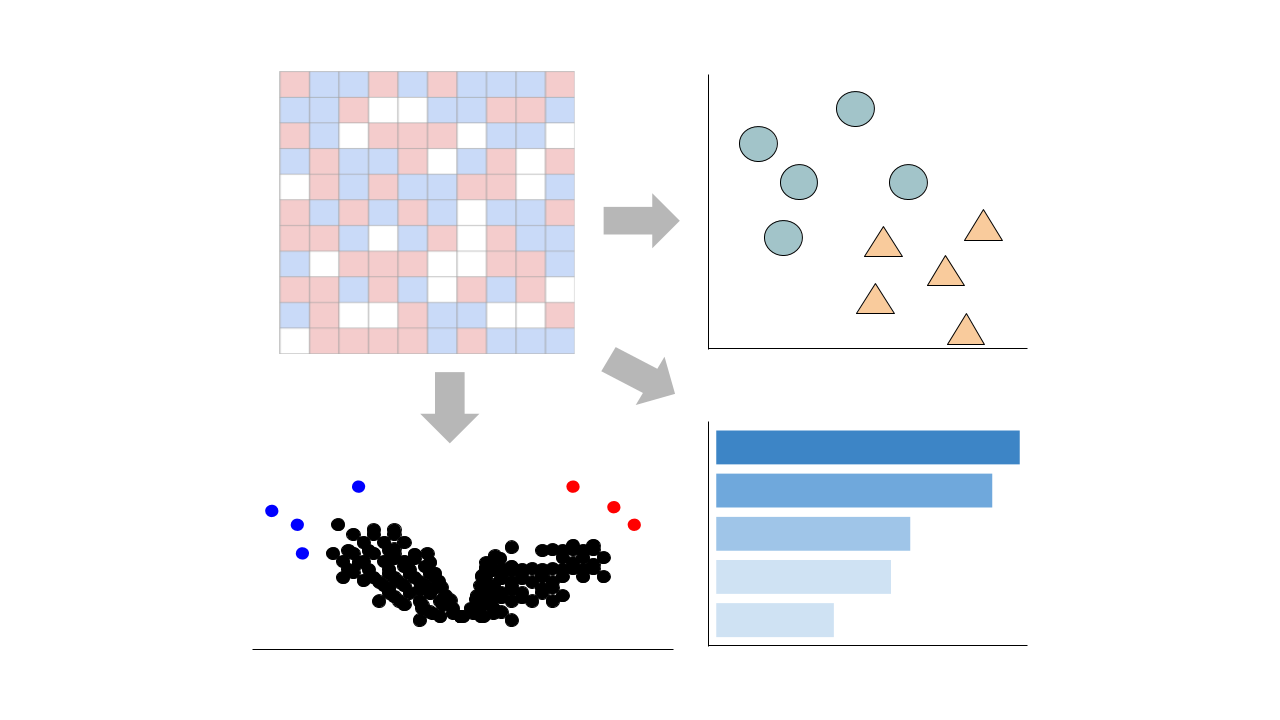 Gene counts are sourced from ARCHS4, which provides uniform alignment of GEO samples.
You can learn more about ARCHS4 and its pipeline here.
Gene counts are sourced from ARCHS4, which provides uniform alignment of GEO samples.
You can learn more about ARCHS4 and its pipeline here.
Select conditions below to toggle them from the plot:
| GROUP | CONDITION | SAMPLES |
|---|---|---|
| HepaRG |
GSM3456189 GSM3456190 GSM3456191
|
|
|
GSM3456192 GSM3456193 GSM3456194
|
Submission Date: Nov 05, 2018
Summary: The present study was aimed to mimic steatosis in in-vitro HepaRG model and test the effect of lipid loading on drug metabolizing enzymes and transporters (DMET) in steatosis. HepaRG cells, differentiated in-house were exposed to mixture of saturated and unsaturated fatty acids, 0.5 mM palmitate and oleate (1:2) conjugated to BSA (0.02%) for 72h. Following the incubation, the model system was characterized using ORO staining for neutral lipids, tested for toxicity with WST-1 assay and triglyceride (TAG) accumulation was measured using TAG calorimetric assay. Increased lipid accumulation and 6-fold increase in TAG was observed (P < 0.05, n=4). The whole transcriptome was analyzed using RNA sequencing. Differentially expressed transcripts were identified upon FA treatment versus (vs.) control in HepaRG cell line (393 total transcripts, 89 up- and 304 downregulated). Lipid loading, led to significant down-regulation in gene expression levels of various DMET, nuclear receptors and transcription factors such as CYP3A4, 1A2, 2B6, 2C8, 2C9 and 2C19, along with this UGT1A9, UGT1A6, ABCB1, NR1I2 and HNF4α (P < 0.05, n=3). The accumulation of saturated and polyunsaturated fatty acids may selectively inhibit certain DME pathways.
GEO Accession ID: GSE122151
PMID: No Pubmed ID
Submission Date: Nov 05, 2018
Summary: The present study was aimed to mimic steatosis in in-vitro HepaRG model and test the effect of lipid loading on drug metabolizing enzymes and transporters (DMET) in steatosis. HepaRG cells, differentiated in-house were exposed to mixture of saturated and unsaturated fatty acids, 0.5 mM palmitate and oleate (1:2) conjugated to BSA (0.02%) for 72h. Following the incubation, the model system was characterized using ORO staining for neutral lipids, tested for toxicity with WST-1 assay and triglyceride (TAG) accumulation was measured using TAG calorimetric assay. Increased lipid accumulation and 6-fold increase in TAG was observed (P < 0.05, n=4). The whole transcriptome was analyzed using RNA sequencing. Differentially expressed transcripts were identified upon FA treatment versus (vs.) control in HepaRG cell line (393 total transcripts, 89 up- and 304 downregulated). Lipid loading, led to significant down-regulation in gene expression levels of various DMET, nuclear receptors and transcription factors such as CYP3A4, 1A2, 2B6, 2C8, 2C9 and 2C19, along with this UGT1A9, UGT1A6, ABCB1, NR1I2 and HNF4α (P < 0.05, n=3). The accumulation of saturated and polyunsaturated fatty acids may selectively inhibit certain DME pathways.
GEO Accession ID: GSE122151
PMID: No Pubmed ID
Visualize Samples
 Visualizations are precomputed using the Python package scanpy on the top 5000 most variable genes.
Visualizations are precomputed using the Python package scanpy on the top 5000 most variable genes.
Precomputed Differential Gene Expression
 Differential expression signatures are automatically computed using the limma R package.
More options for differential expression are available to compute below.
Differential expression signatures are automatically computed using the limma R package.
More options for differential expression are available to compute below.
Signatures:
Select conditions:
Control Condition
Perturbation Condition
Only conditions with at least 1 replicate are available to select
 Differential expression signatures can be computed using DESeq2 or characteristic direction.
Differential expression signatures can be computed using DESeq2 or characteristic direction.
This pipeline enables you to analyze and visualize your bulk RNA sequencing datasets with an array of downstream analysis and visualization tools. The pipeline includes: PCA analysis, Clustergrammer interactive heatmap, library size analysis, differential gene expression analysis, enrichment analysis, and L1000 small molecule search.

 Chatbot
Chatbot Single Gene Queries
Single Gene Queries
 Gene Set Queries
Gene Set Queries
 Bulk Studies
Bulk Studies
 Single Cell Studies
Single Cell Studies
 Hypotheses
Hypotheses
 Resources
Resources
 Contribute
Contribute
 Downloads
Downloads About
About
 Help
Help